AN HOUR AROUND THE ACER CAMPESTRE
Two months ago, on the 24th of June 2022, I drove to the area around the village of Shishan, four or five kilometers from where I live, and spent about an hour or so photographing the stuff along the edge of one of the meadows there.
In this opening picture, you can see an interesting insect that I have never seen before or since that occasion. I mean, I saw the adult version of this leafhopper a year before, but I wasn't aware of the connection between the two while taking this photograph.
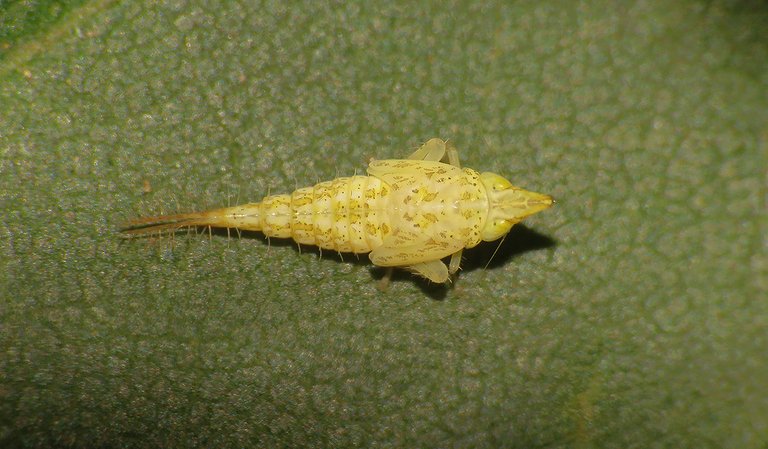
You can take a look from above here. This larva has a pale yellow color with green markings.
Some of those larvae were slightly different. White with olive-green markings.
Here you can see a completely developed adult.
Both the adults and the larvae were resting on the foliage of the Acer campestre, a small, shrub-like tree commonly known as the field maple.

The main reason why I'm publishing these fairly old photographs only today, two months later, is the inability to identify this leafhopper. The Internet sites about the European Cicadellidae, sites that I usually use, just couldn't help me this time. I did quite a few extensive searches between the 24th of June and today - with no results.
Only today, early in the morning, when I extended the search to the leafhoppers that live in other parts of the world, did I find the name of the species.
This is the Japananus hyalinus ...
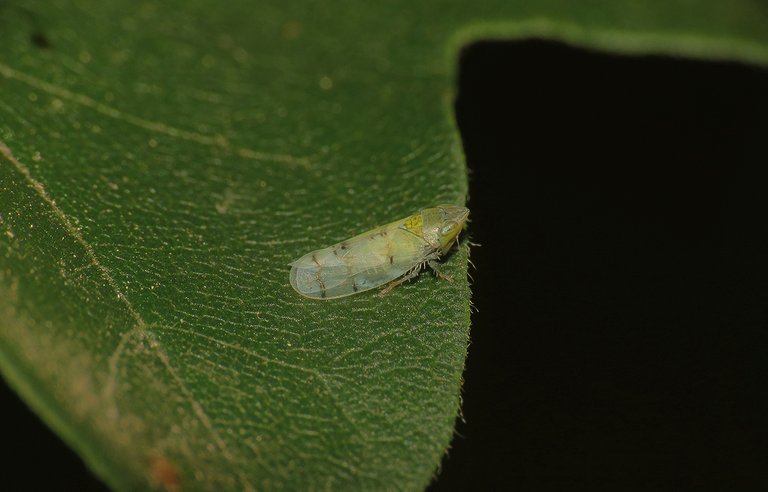
... commonly known as the Japanese maple leafhopper. Native to temperate and sub-tropical regions of eastern Asia. Through the trade with cultivated maples, it has been carried to North America, Europe, and Australia.
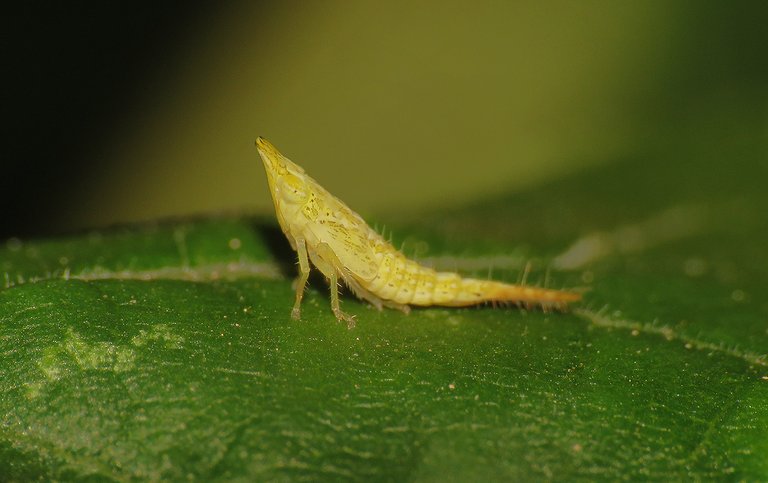
In its Asian habitats, Japananus hyalinus feeds and reproduces on two types of maple, the Acer japonicum, and Acer palmatum. While spreading across other continents, the species has adapted to use other plants from the genus Acer of the Sapindaceae family. Acer campestre is one of them.The adults and the larvae feed on the sap of the plant by piercing the veins of the leaves with their proboscis. Females insert the eggs into the nodes of young branches. The eggs are well-hidden and protected there.
On the European continent, this leafhopper was first detected in Austria and Romania. The year was 1961. In my area, it was first detected during the late 80'.

Feeding activities of the Japananus hyalinus don't leave any marks or symptoms on the host plant and the field maple trees here where I live don't seem to have any problems with this relatively recent pest.
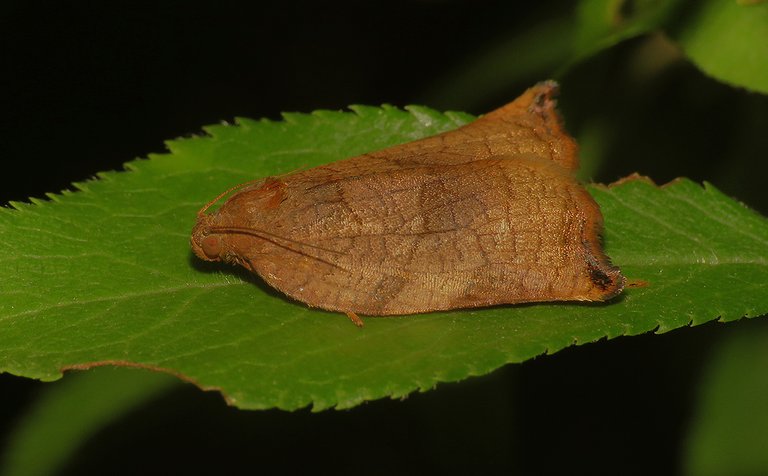
This small moth from the Tortricidae family was first photographed on another small tree that grows on the edge of the meadow, the blackthorn (Prunus spinosa). After I took this shot, the moth flew away ...
... and soon landed on the underside of the maple's leaf. Besides the moth and the leaf, you can also see the fruit of the Acer campestre tree in this enlargeable photograph.
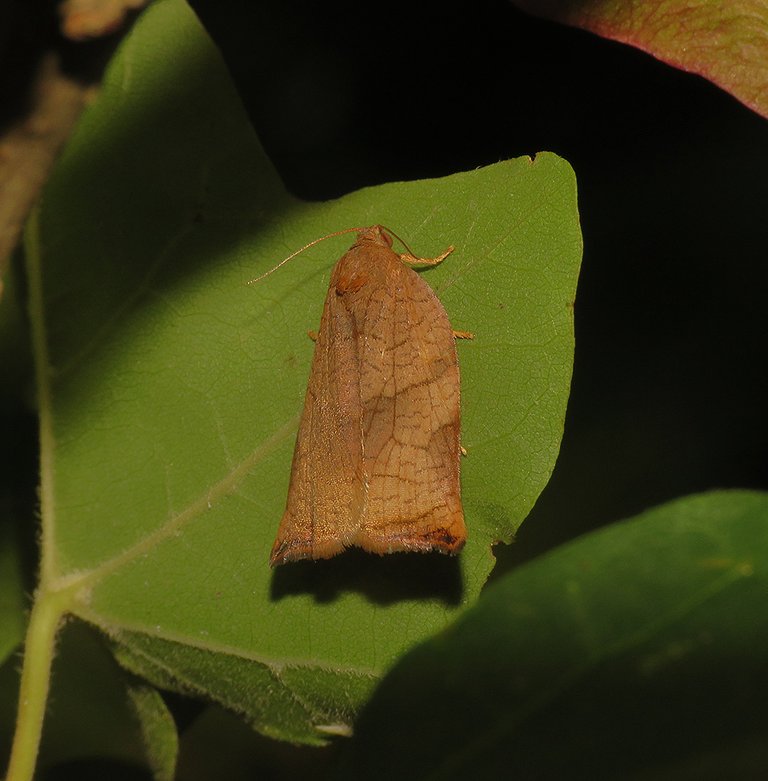
The scientific name of this moth species is Archips podana.

On the same tree, on the upper surface of another leaf, I found another species from the Tortricidae family. The Ancylis achatana.

I saw many ants, but they were always in motion, so I wasn't able to get more than one photograph.
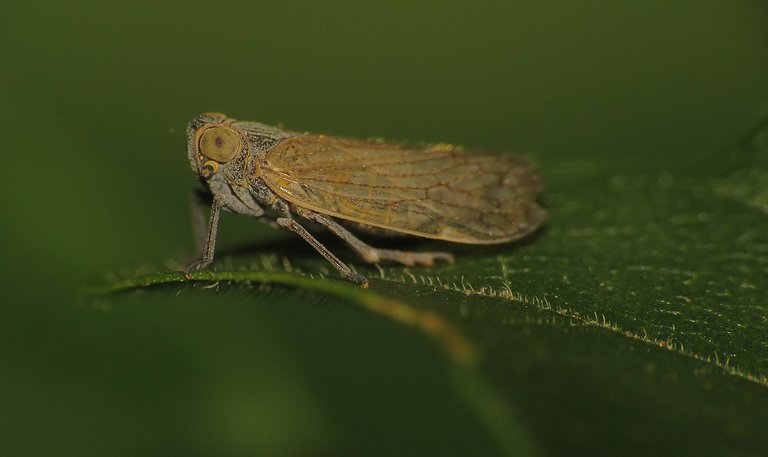
This is the Oliarus leporinus, a planthopper from the Cixiidae family. Planthoppers from this family are often commonly called lacehoppers.
Half an hour later, on the same tree, the lacehopper ended up in the fangs of a jumping spider.
When it comes to the spider in this series of photographs, I can't tell you the exact species. The genus is probably Carrhotus. The family is Salticidae, of course.
I observed the scene for a couple of minutes, and then ...

... I noticed this fluffy stuff on the lower surface of the leaf. It looks that some small caterpillar has left its old skin here. That's all I can tell you about the scene.

At this point, the sun was going down, and the light was getting low. I photographed only this Athous bicolor, a beetle from the Elateridae family, before reaching the car and driving back home.
In this last shot, you can take another look at the tree in the center of today's theme.
The following links will take you to the sites with more information about the protagonists of this post. I found some stuff about them there.
https://www.theedkins.co.uk/insects/japananus.htm
https://www.plantea.com.hr/javor-klen/
https://www.leps.it/
https://en.wikipedia.org/wiki/Carrhotus
https://www.kerbtier.de/cgi-bin/enFSearch.cgi?Fam=Elateridae
AND THAT'S IT. AS ALWAYS IN THESE POSTS ON HIVE, THE PHOTOGRAPHS ARE MY WORK - THE END.


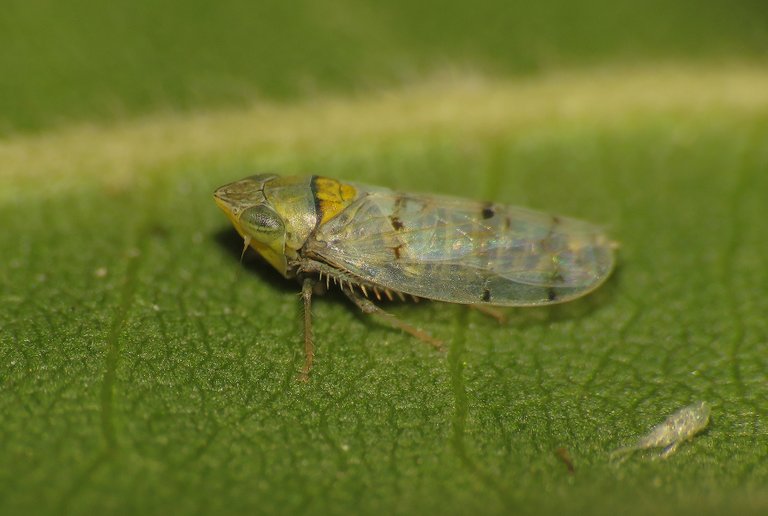



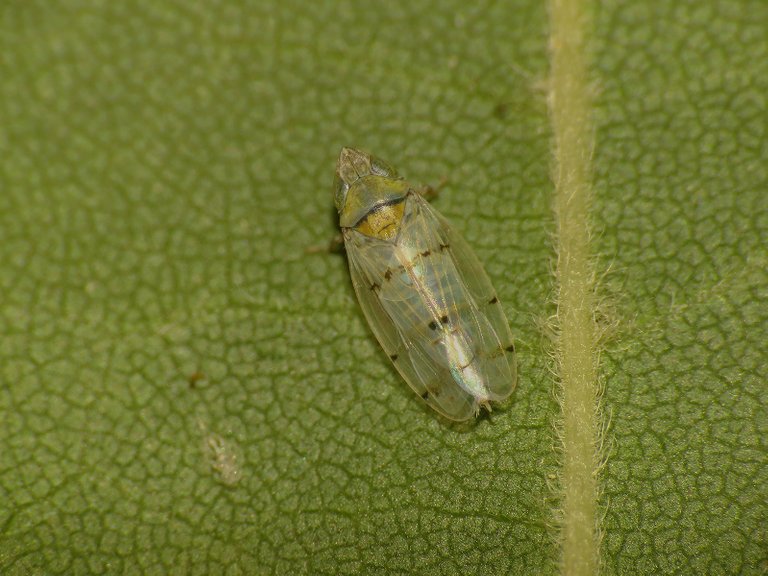
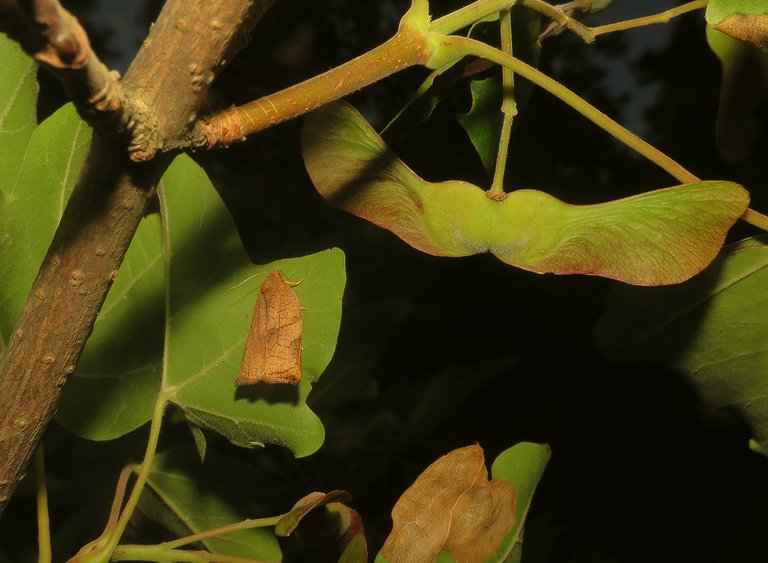

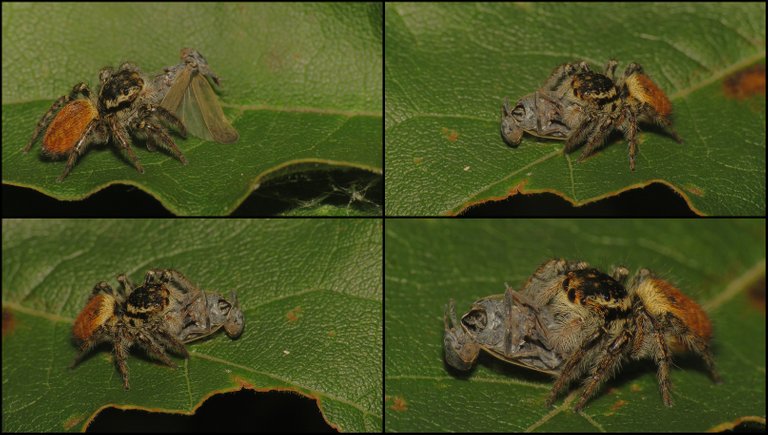

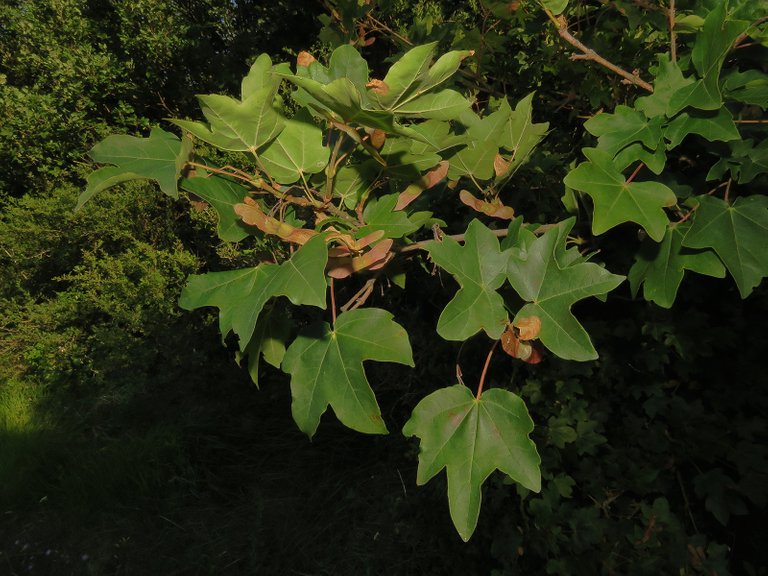
That yellow leaf hopper looks almost like a fish to me. Haha. It's pretty cool.
Pretty cool seeing the spider catch its prey too.
Heehehe yes. It definitively looks like something that wouldn't be out of place in an aquarium. A minuscule fish. Or some kind of shrimp.
Thank you for your witness vote!
Have a !BEER on me!
To Opt-Out of my witness beer program just comment STOP below
View or trade
BEER.Hey @borjan, here is a little bit of
BEERfrom @isnochys for you. Enjoy it!Learn how to earn FREE BEER each day by staking your
BEER.This post has been manually curated by @bhattg from Indiaunited community. Join us on our Discord Server.
Do you know that you can earn a passive income by delegating to @indiaunited. We share 100 % of the curation rewards with the delegators.
Here are some handy links for delegations: 100HP, 250HP, 500HP, 1000HP.
Read our latest announcement post to get more information.
Please contribute to the community by upvoting this comment and posts made by @indiaunited.
I honestly don't remember ever seeing the first insect before. Really interesting thanks for sharing some beautiful photography.
!discovery 30
This post was shared and voted inside the discord by the curators team of discovery-it
Join our community! hive-193212
Discovery-it is also a Witness, vote for us here
Delegate to us for passive income. Check our 80% fee-back Program
Incredible detailed pictures. Curious to learn from them.
!WINE
Congratulations, @valerianis You Successfully Shared 0.100 WINEX With @borjan.
You Earned 0.100 WINEX As Curation Reward.
You Utilized 1/1 Successful Calls.
Contact Us : WINEX Token Discord Channel
WINEX Current Market Price : 0.180
Swap Your Hive <=> Swap.Hive With Industry Lowest Fee (0.1%) : Click This Link
Read Latest Updates Or Contact Us
I remember our Zoology subject in the school and that we also had to remember their names. But we studied only very common ones and also living in our area. Nowadays we know that every country has its own specific species.
The moth on leave looks like a dray leave, I actually have not realized that it is a moth. The scene with spider is very dramatic, but that is life either to eat ot been eaten.
lovely shots and some great macro's , thank you for sharing
Thanks 🙂 Glad you like the post
Such an interesting looking creature, never seen one before either. That’s interesting to hear 🤓
Great captures especially of the spider.
Thanks for sharing @borjan 😊
Have a great Friday 👋🏻
Congratulations @borjan! You received a personal badge!
Participate in the next Power Up Day and try to power-up more HIVE to get a bigger Power-Bee.
May the Hive Power be with you!
You can view your badges on your board and compare yourself to others in the Ranking
Check out the last post from @hivebuzz:
We appreciate your work and your post has been manually curated on behalf of Insects Of The World Community. It will be added to the weekly curation report. Keep up the good work.
Hello @borjan, months ago I found an insect similar to that first one and made a publication months later without being able to identify it. It was gray, with a very long tail that moved constantly. It also had white cotton-like hairs or specks on its legs. I assumed that it was an immature stage of cicadas or dragonflies. Coincidentally more recently I also found a jumping spider eating a leafhopper. I thought maybe it's good to control its population. As always, your images are magnificent, congratulations.